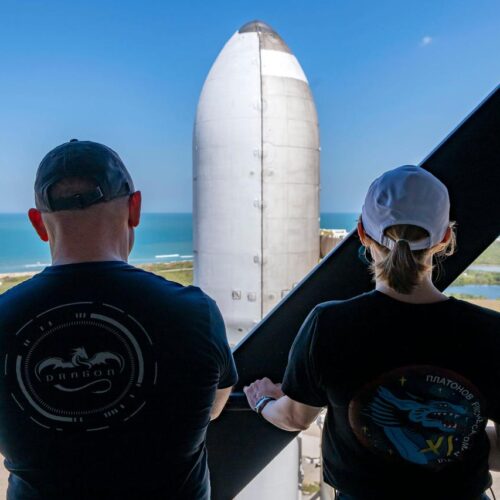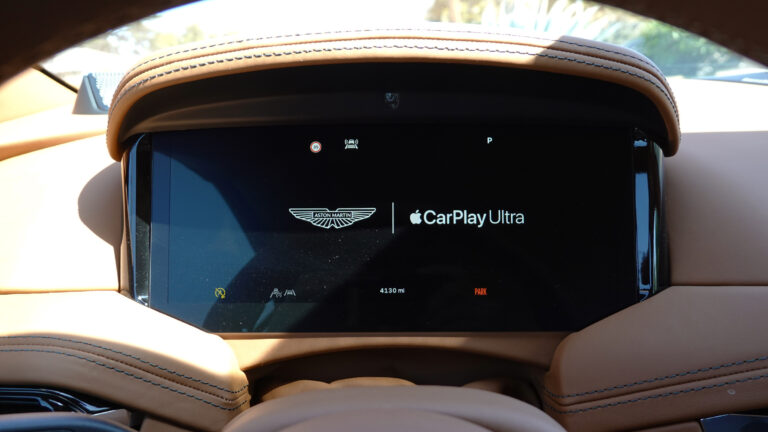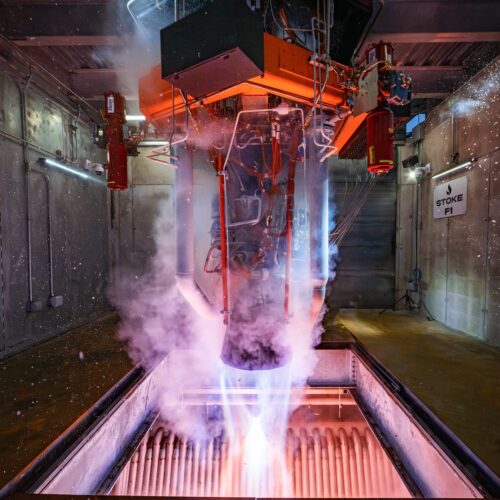All the news that’s fit to lift
“Europe is seizing the opportunity to lead.”
NASA astronauts Mike Fincke (left) and Zena Cardman (right), the pilot and commander of NASA’s SpaceX Crew-11 mission to the International Space Station, view a Falcon 9 rocket ahead of their spaceflight. Credit: SpaceX
Welcome to Edition 8.03 of the Rocket Report! We are at an interesting stage in Europe, with its efforts to commercialize spaceflight. Finally, it seems the long-slumbering continent is waking up to the need to leverage private capital to drive down the costs of space access, and we are seeing more investment flow into European companies. But it is critical that European policymakers make strategic investments across the industry or companies like PLD Space, which outlined big plans this week, will struggle to get off the launch pad.
As always, we welcome reader submissions, and if you don’t want to miss an issue, please subscribe using the box below (the form will not appear on AMP-enabled versions of the site). Each report will include information on small-, medium-, and heavy-lift rockets, as well as a quick look ahead at the next three launches on the calendar.

Avio celebrates freedom from Arianespace. Representatives from Italy, Germany, and France met at the European Space Agency headquarters last week to sign the Launcher Exploitation Declaration, which officially began the transfer of Vega C launch operation responsibilities from Arianespace to the rocket’s builder, Avio, European Spaceflight reports. “It is a historic step that reinforces our nation’s autonomy in access to space and assigns us a strategic responsibility towards Europe,” said Avio CEO Giulio Ranzo. “We are ready to meet this challenge with determination, and we are investing in technologies, expertise, and infrastructure to ensure a competitive service.”
A breaking of long-term partnerships … In addition to securing control over the full exploitation of the Vega launch vehicle family, Italy, through Avio, is also investing in what comes next. The country has committed more than 330 million euros to the development of the MR60 methalox rocket engine and two demonstrator vehicles. These, along with the MR10 engine being developed under the Vega E programme, will support Avio’s preparation of a future reusable launch vehicle. Historically, France, Germany, and Italy have worked together on European launch vehicles. This appears to be another step in breaking up that long-term partnership toward more nationalistic efforts.
PLD Space outlines grand ambitions. PLD Space, Spain’s sole contestant in the European Launcher Challenge, unveiled its long-term strategy at the company’s Industry Days event this week, Payload reports. The company is targeting a production rate of 32 Miura 5 launchers annually by 2030. To achieve this output, PLD plans to deepen its vertical integration, consolidate its supplier network, and begin to serialize its manufacturing process beginning in 2027.
Building up the supply chain … The company’s production plans also call for the parallel development of Miura Next, a heavy-lift vehicle capable of bringing 13 tons to orbit. However, the company will start with the Miura 5 vehicle, which PLD expects to launch for the first time from French Guiana in 2026. Since the beginning of 2024, PLD has invested a total of 50 million euros in its Miura 5 supply chain, consisting of 397 industrial partners, many of which are located in Spain and other European countries. These plans are great, but sooner or later, the 14-year-old company needs to start putting rockets in space. (submitted by EllPeaTea)
The easiest way to keep up with Eric Berger’s and Stephen Clark’s reporting on all things space is to sign up for our newsletter. We’ll collect their stories and deliver them straight to your inbox.
New consortium will study space plane. A UK-based space and defense consultant group, Frazer-Nash, will lead a program to design a vehicle and its integrated systems with the goal of building and flying a Mach 5-capable aircraft at the edge of space by early 2031. This so-called INVICTUS program was funded with a 7 million-euro grant from the European Space Agency and is seen as a stepping stone toward developing a reusable space plane that takes off and lands horizontally from a runway.
Seeking to lead a new era of flight … Over 12 months, INVICTUS has been tasked to deliver the concept and elements of the preliminary design of the full flight system. It will attempt to demonstrate the efficacy of hydrogen-fueled, precooled air-breathing propulsion at hypersonic speeds, technology that will ultimately enable horizontal take-off. “With INVICTUS, Europe is seizing the opportunity to lead in technologies that will redefine how we move across the planet and reach beyond it,” said Tommaso Ghidini, head of the Mechanical Department at the European Space Agency. (submitted by Jid)
ESA backs North Sea launch site. A private company developing a launch site in the North Sea, EuroSpaceport, has secured support from the European Space Agency. The company, founded five years ago, is developing a sea-based launch platform built on a repurposed offshore wind turbine service vessel, European Spaceflight reports. Rockets are envisioned to launch from a position 50 to 100 km offshore from the port of Esbjerg, in Denmark.
Seeing the forest for the trees … On Wednesday, EuroSpaceport announced that it had signed an agreement with the European Space Agency and Polish rocket builder SpaceForest to support the first launch from its Spaceport North Sea platform. The company will receive support from the agency through its Boost! Program. SpaceForest has been a recipient of Boost! funding, receiving 2.4 million euros in October 2024. SpaceForest said the mission will be used to verify the launch procedures of its Perun rocket under nominal suborbital conditions. (submitted by EllPeaTea)

Amazon and SpaceX, best frenemies? Maybe not, but for the time being, they appear to be friends of convenience. A Falcon 9 rocket launched from Florida’s Space Coast early on Wednesday with a batch of Internet satellites for Amazon’s Project Kuiper network, thrusting a rival one step closer to competing with SpaceX’s Starlink broadband service. With this launch, Amazon now has 78 Kuiper satellites in orbit, Ars reports. The full Kuiper constellation will consist of 3,232 satellites to provide broadband Internet service to most of the populated world, bringing Amazon in competition with SpaceX’s Starlink network.
Launch is not cheap … Kuiper is an expensive undertaking, estimated at between $16.5 billion and $20 billion by the industry analytics firm Quilty Space. Quilty has concluded that Amazon is spending $10 billion on launch alone, exceeding the company’s original cost estimate for the entire program. Amazon has booked more than 80 launches to deploy the Kuiper constellation, but the company didn’t turn to SpaceX until it had to. A shareholder lawsuit filed in 2023 accused Amazon founder Jeff Bezos and the company’s board of directors of breaching their “fiduciary duty” by not considering SpaceX as an option for launching Kuiper satellites. The plaintiffs in the lawsuit alleged Amazon didn’t consider the Falcon 9 due to an intense and personal rivalry between Bezos and SpaceX founder Elon Musk. Amazon bowed to the allegations and announced a contract with SpaceX for three Falcon 9 launches in December 2023 to provide “additional capacity” for deploying the Kuiper network.
NASA targets end of July for Crew-11. NASA said Monday that it and SpaceX were targeting July 31 for the flight of SpaceX’s Crew-11 mission to the orbiting outpost, Spaceflight Now reports. The mission is led by NASA astronaut Zena Cardman. She will be flying along with fellow NASA astronaut Mike Fincke, Japan Aerospace Exploration Agency (JAXA) astronaut Kimiya Yui and Roscosmos cosmonaut Oleg Platonov.
Pushing Dragon reuse … The mission was moved up from its previously planned August launch window to create more room in the manifest for the arrival of the Cargo Dragon flying the CRS-33 mission. That Dragon will perform a boost of the space station as a demonstration of some of the capabilities SpaceX will use on its US Deorbit Vehicle currently in work. Crew-11 will fly to the orbiting outpost on Crew Dragon Endeavour, which will be its sixth trip to the ISS. This will be the first Crew Dragon spacecraft to fly for a sixth time.

SpaceX won’t use Johnston Atoll for rocket cargo tests. Johnston Atoll, an unincorporated US territory and Pacific island wildlife refuge with a complicated military history, will no longer become a SpaceX reusable rocket test site, Popular Science reports. “The Department of the Air Force has elected to hold the preparation of the Johnston Atoll Environmental Assessment for a proposed rocket cargo landing demonstration on Johnston Atoll in abeyance while the service explores alternative options for implementation,” Air Force spokesperson Laurel Falls said.
Taking a toll on the atoll … Located roughly 860 miles southwest of Hawaii, Johnston Atoll has served as a base for numerous US military operations for over 90 years. Despite this, the atoll remains a home for 14 tropical bird species as part of the Pacific Remote Islands Marine National Monument. The site had been under consideration for tests as part of a military program to deliver cargo around the planet, using suborbital missions on rocket such as SpaceX’s Starship vehicle. The Johnston Atoll plans included the construction of two landing pads that were met with public backlash from wildlife experts and indigenous representatives. (submitted by Tfargo04)
Blue Origin confirms ESCAPADE is up next. On Thursday, Blue Origin said on social media that the second launch of its New Glenn rocket will carry NASA’s ESCAPADE mission as its primary payload. This launch will support ESCAPADE’s science objectives as the twin spacecraft progress on their journey to the Red Planet. Also onboard is a technology demonstration from @Viasat in support of @NASASpaceOps’ Communications Services Project.
Left unsaid was when the launch will occur … The social media post confirms a report from Ars in June, which said the ESCAPADE spacecraft was up next on New Glenn. Previously, the company has said this second launch will take place no earlier than August 15. However, that is less than one month away. Late September is probably the earliest realistic launch date, with October or November more likely for the second flight of the company’s large rocket.
Next three launches
July 19: Falcon 9 | Starlink 17-3 | Vandenberg Space Force Base, California | 03:44 UTC
July 21: Falcon 9 | O3b mPOWER 9 & 10 | Cape Canaveral Space Force Station, Florida | 21:00 UTC
July 22: Falcon 9 | NASA’s Tandem Reconnection and Cusp Electrodynamics Reconnaissance Satellites | Vandenberg Space Force Base, California | 18:05 UTC

Eric Berger is the senior space editor at Ars Technica, covering everything from astronomy to private space to NASA policy, and author of two books: Liftoff, about the rise of SpaceX; and Reentry, on the development of the Falcon 9 rocket and Dragon. A certified meteorologist, Eric lives in Houston.






